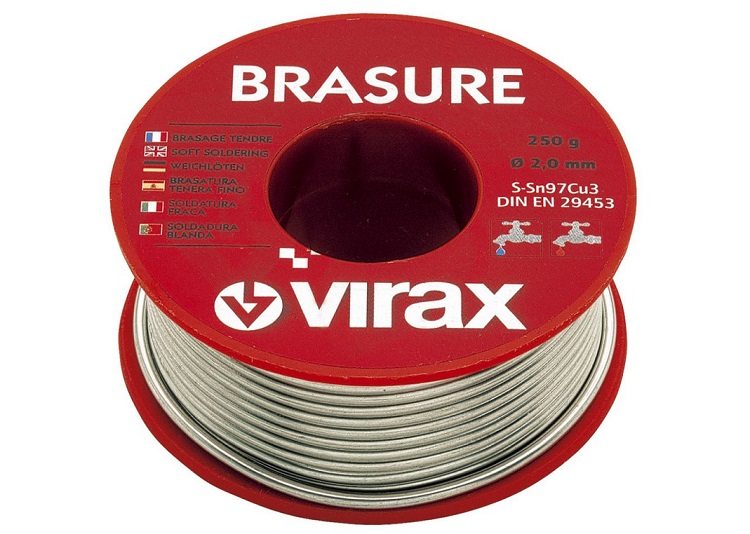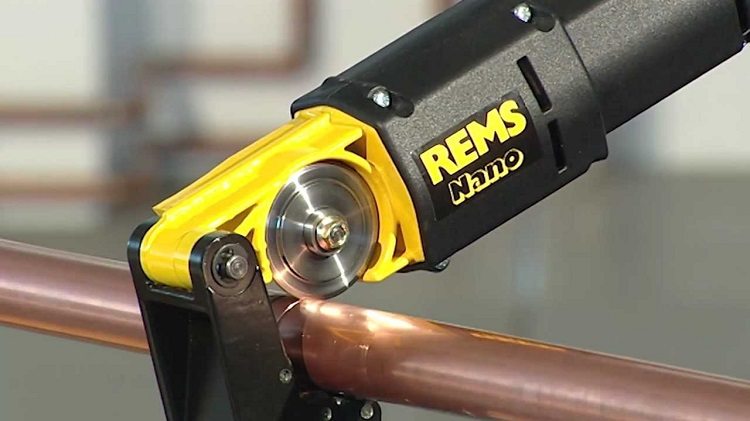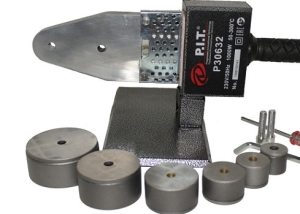At pipeline installation It is important to ensure reliable adhesion of system elements. Capillary brazing is the most common way to join pipes. To perform the work, a special tool is needed - a pipe cutter, a chamfer, a reamer, and also a soldering iron for copper pipes. The functions of the latter can be performed by a special gas burner, sometimes a building hair dryer or an electric soldering iron.
Content
Solder and Solder Method Overview
Soldering is the preparation of an inseparable joint by introducing solder between parts. The solder has a melting point lower than that of the parts to be joined, and due to the capillary effect it is evenly distributed over the surface of copper pipes regardless of their position. The use of fluxes and the cleaning of joined surfaces allows the adhesion coefficient and soldering to be improved. There are two methods. soldering copper pipes:
- Low temperature - used for domestic systems. The connection occurs when brazing with solder with a temperature above 450 ° C, soft solder - less than 400 ° C.
- High temperature - used for systems with significant load. Solder melting occurs at a temperature of 600-900 ° C.
Soft solder is a wire with a diameter of 2 to 3 mm, made of lead, tin, alloys from them, sometimes with the addition of silver or other elements. Brazing alloy is made in the form of rods. The combination with its use is resistant to high temperatures and pressure.
Self-fluxing copper-phosphorus solders containing silver are also common. They are characterized by higher deformation characteristics, heat resistance (up to 200 ° C), environmental safety, improved fluidity and do not cause corrosion. The addition of phosphorus makes it possible to reduce the melting temperature of copper to 750 ° C, and almost equal coefficients of thermal expansion of copper and solder increase the strength of the joint.
Soldering equipment
For soldering, you need:
- tool for pipes;
- solder used for soldering;
- soldering iron (gas burner), melting solder.
Before joining, preparatory work is carried out for soldering copper pipes. Tools are selected based on the maximum diameter of the pipe used and the type of substance that will be in it during operation.
A pipe cutter is used to cut the product perpendicular to the axis. You can remove burrs from the outer and inner edges to facilitate the insertion of pipes into each other using chamfers. They come in a round case and in the form of a pencil. A round tool is more convenient, but it is more expensive and limited by a pipe diameter of 0.36 cm.
The end of one pipe, into which the end of the other will be placed, must be expanded with a pipe expander to a depth equal to its diameter.
Important! The pipe to be expanded must be soft or annealed.
Preparation of the inner surface of copper pipes is carried out with special sponges or brushes.The outside is brushed. Surface heating over the entire joint area is carried out by a torch for soldering copper pipes. A reflector is installed on its nozzle to prevent heat loss and protect nearby combustible materials.
Types of gas burners
Gas burners for brazing copper pipes are equipment consisting of:
- assembly for mounting a gas cylinder;
- nozzles;
- instrument head;
- devices for adjusting the gas supply;
- gearbox.
Different models of burners for brazing copper pipes can be equipped with auxiliary parts - adapters, lugs, etc. According to the criterion of the combustible mixture used, this equipment is divided into:
- propane burners for brazing copper pipes;
- MAPP gas tool.
According to technical capabilities, they distinguish: household gas burners (flame temperature from 1000 to 1500 ° C) and industrial (flame temperature from 1500 to 2000 ° C).
Acetylene-oxygen burners can also be distinguished; with a cylinder for single use or on a stationary basis. This equipment allows you to provide highly reliable connection of highways and components of different systems with hard and soft solder.
Propane burner is universal and special purpose. It is usually equipped with a piezoelectric ignition function, a gas saving mode and its supply. A MAPP gas brazed copper burner is more efficient than propane due to its high combustion energy. Despite the rather high combustion temperature, the flame is soft and does not burn the pipe material.
Soldering of edge and corner places is done with a gas soldering iron for copper pipes.
Disposable and stationary burners
The most compact equipment for soldering copper pipes is a gas burner with a disposable cylinder. For fuel, you can use acetylene, propane or other gas mixtures. On the handle of the burner is a valve that regulates the flow of fuel. The advantages of using such a device for soldering copper products:
- Simplicity: there is no need for a power source, the equipment is convenient to operate.
- Multifunctionality: up to five different nozzles fit on one handle.
- Mobility: it is possible to adjust the flame power, the position relative to the connection, the heating rate.
- Safety: the tool is equipped with check valves, which, if necessary, block the gas supply.
- High quality: the joints will be strong and durable if the conditions of the technology of welding with gas torches are met.
Gas burners with a stationary cylinder provide a high-quality connection. Their flame can melt almost all the metals that are used in industry.
Important! The diameter of the joint is half as large if brazing the copper pipes. Burners for this technology can choose acetylene-oxygen.
Features of the choice of gas burners
The choice of gas equipment for soldering copper pipes is quite large. Many manufacturers are represented on the market, for example, Rems, Rothenberger, etc. The price range is wide and depends on the model.
The functions of the burner involve not only soldering, but also metal cutting, defrosting, processing at high temperatures, heating. Propane burner is convenient when working in the wind.
The tool is selected according to the following characteristics:
- burner type: injector, non-injector;
- power: the larger it is, the more efficient the work with thick-walled pipes;
- type of gas: for example, propane, acetylene. Some burners are multifunctional and can be used with other gas. It is recommended to purchase a tool that runs on the same type of fuel. Propane burner is mainly used in industry.
- mission: if the burner is made for soldering, then it is not very suitable for cutting;
- material of products to be processed.
Soldering copper pipes requires compliance with safety regulations: wear protective gloves that will protect your hands from burns; carry out work in a well-ventilated room with good ventilation; Before checking the connection, make sure that it has cooled down.
Some rules for soldering
Surface cleanliness is an important condition for reliable soldering. It is forbidden to use abrasive materials for stripping. Oil, dirt, grease, etc. should not get on the surface, as this will prevent wetting and solder from entering the joint. After inserting one pipe into another, a gap of 25-125 microns should remain between the outer and inner walls.
To prevent air from entering the seam, to remove oxides, to increase the fluidity of solder, and to improve adhesion, fluxes or pastes are used. They are high temperature (more than 450 ° C) and low temperature (up to 450 ° C). The flux for soldering copper pipes is applied with a brush in an even thin layer.
The pipes are heated along the entire length and circumference of the joint, distributing the heat evenly. The flame of the burner should be slightly reduced, since overheating enhances the interaction of solder with metal, and this adversely affects the service life of the connection. The simultaneous introduction of solder and flame into the soldering zone will lead to uneven heating. A heated solder enters the joint under the action of capillary forces.
Important! After the soldering process is completed, flux residues should be removed to prevent leakage and corrosion of the metal.
Phased brazing of pipe joints
When soldering with soft solder, the process has the following sequence:
- the joint is assembled processed and expanded under the bell;
- a flux is applied to the inner zone of the socket and the outer surface of the copper pipe and the tube assembly is assembled;
- equipment for soldering copper pipes warms up to 300-400 ° C at the junction. Control of the heating temperature occurs according to the color of the flux: only it begins to darken - it is necessary to take solder.
- having unwound the wire solder, its end is introduced into the soldering zone. In contact with a heated pipe, it melts, glides along the flux to the seam, fills the space between the bell and the pipe. In the process of soldering, the pipe turns.
During the soldering process, an influx of the heated mass of solder may form at the seam.
When high-temperature brazing of copper pipes using brazing alloy, the process differs at the stage of its melting:
- the joint assembly is assembled and processed by flux;
- using the necessary equipment, the structure is heated and placed on a heat-resistant surface;
- solder is introduced into the junction of the socket and the pipe, which is heated by a gas burner;
- the pipe is slightly rotated and the solder softened by the burner is wound on the subsequent part of the joint until an annular seam is obtained.
The tightness and soldering quality of copper parts depends on the physical characteristics of the joint and the soldering process. Joining the pipes with gas burners can be done independently; connections of increased strength are performed by special equipment.












